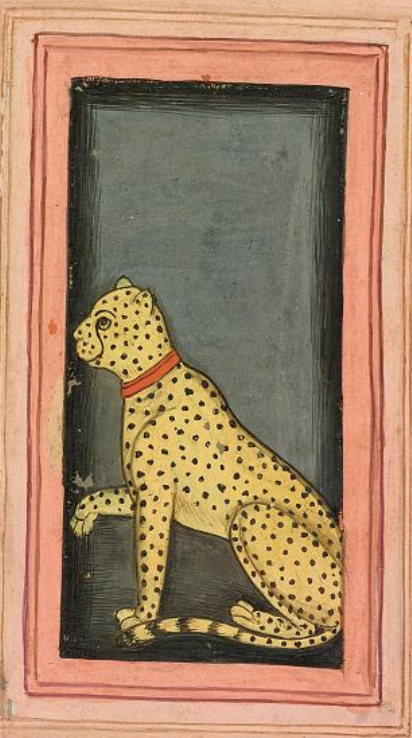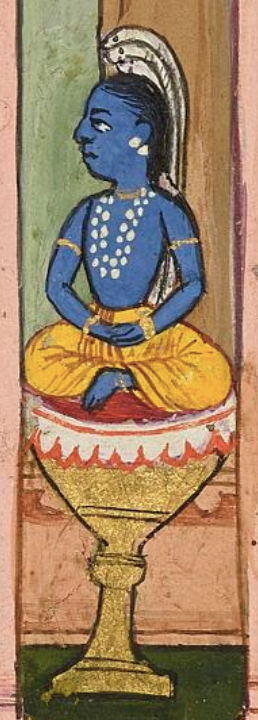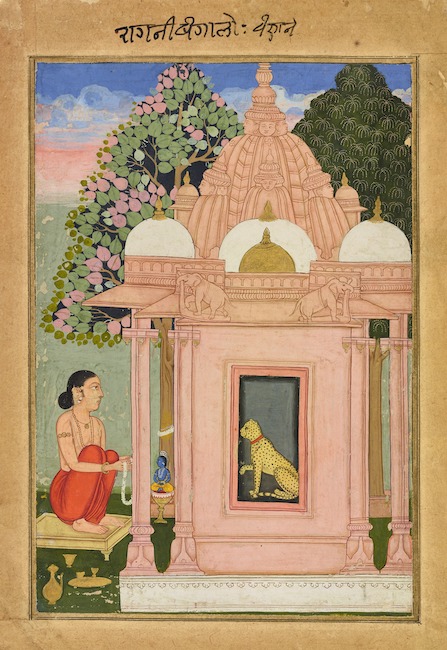Bangali Ragini
Bangali Ragini
India, Rajasthan, Marwar, ca. 1630
Opaque watercolor and gold on paper
Courtesy the Arthur M. Sackler Gallery, Smithsonian Institution, Washington, D.C.: Purchase and partial gift from the Catherine and Ralph Benkaim Collection — funds provided by the Friends of the Freer and Sackler Galleries, S2018.1.50
In this painting, the identity of the young man remains unknown. However, the man is identifiable as a prince because he is adorned with beautiful jewelry. His pearl and ruby earrings first came into style for princes during the reign of the Mughal emperor Jahangir (1605-1627). Bangali Raginiscommonly represent a female ascetic wearing a sacred thread who sits beside a shrine or in meditation while holding prayer beads. This painting contains aspects of the typical iconography but instead of featuring a female ascetic, it depicts a devout prince performing a religious ritual (puja). The prince also wears a sacred thread of munja grass.

This unusual painting depicts a cheetah sitting in a temple dedicated to the Hindu god, Vishnu. To the left sits a young man adorned with beautiful jewelry, indicating that he may be a devout prince. Royalty were known for keeping cheetahs as pets and using them during the hunt, so this feline most likely belonged to him. The prince is not worshiping the cheetah but instead is showing devotion to a small icon of Vishnu. The red collar makes it clear that the animal has been tamed.
The prince is shown worshiping a small icon of the god, Vishnu. In the Hindu religion, devotion and love for a deity can be expressed through religious rituals (pujas). Here, the prince is offering a flower garland (mala) to Vishnu. This image of worship and devotion embodies the musical mode of Vangala, which is meant to be sung during the autumn season in the mornings. Vangala is a variant regional spelling of Bangali, which is the title of this ragini. Scholars identified the painting because a similar Marwar painting from 1605 contains a poetic verse that describes a young man singing a sacred hymn: “His body is decorated with a beautiful string of grass. He wears the skin of a young doe. He is a vigorous youth. His body shines with the brilliance of gold. He sings the sacred hymn, Vangala.”

The small icon worshiped by the prince can be identified as the Hindu deity Vishnu because of his blue skin, traditional yellow garment, and long garland. While Vishnu is customarily shown with four arms, this small icon depicts him with two. He is being shaded by the multi-headed serpent (naga) Shesha.
It is rare for paintings of Bangali Ragini to depict temple architecture in such detail. This temple contains the architectural features of Hindu temples in north India. The roof is elaborately decorated with domes, elephants, and faces. The inclusion of this architecture helped to link court painting and devotional imagery, thus fortifying a connection between the religious and the courtly
